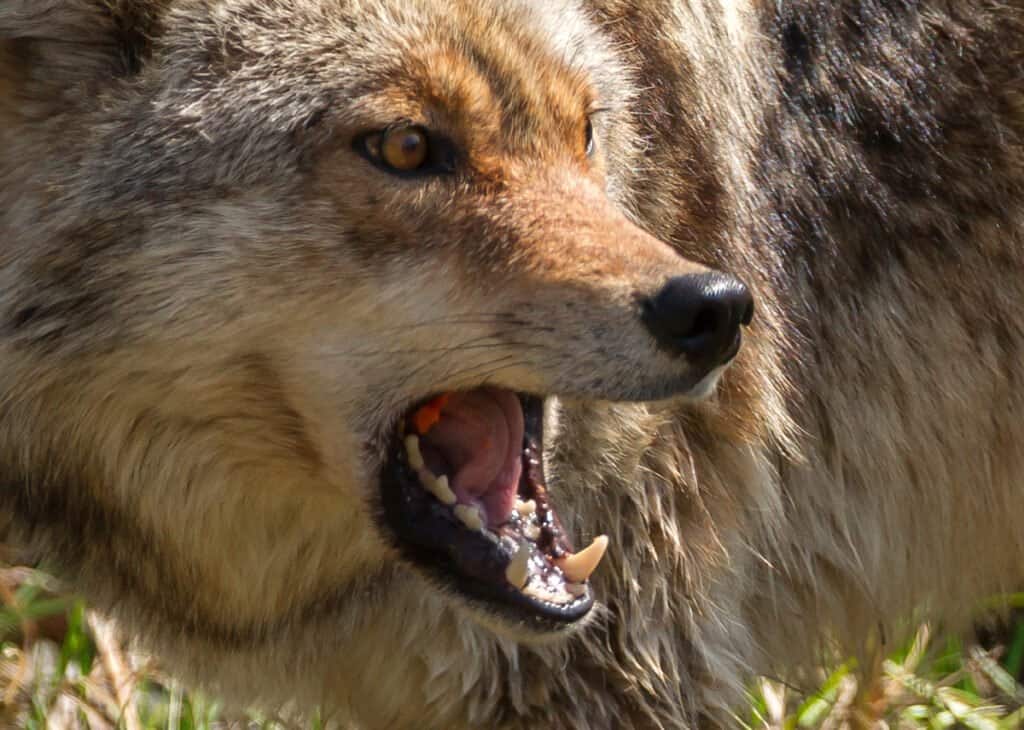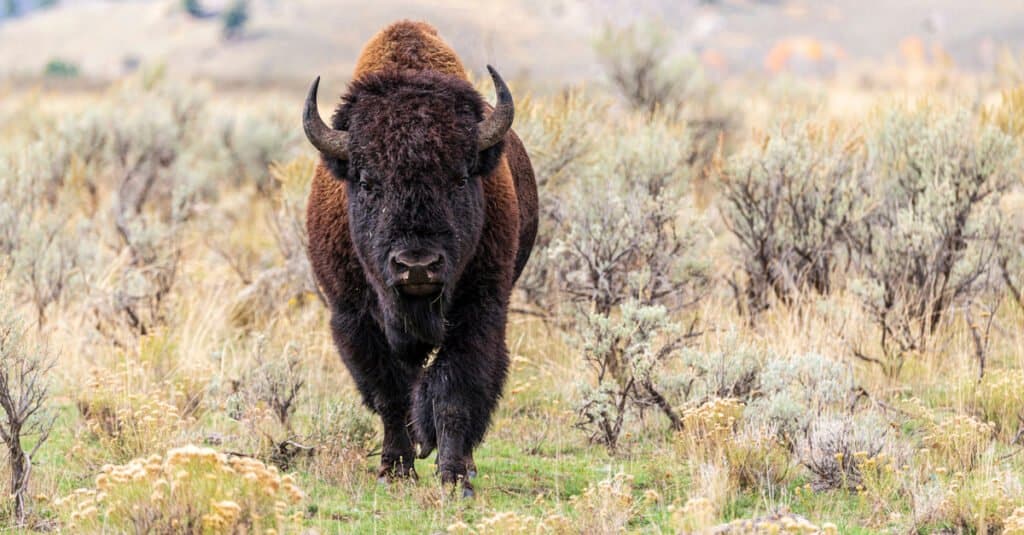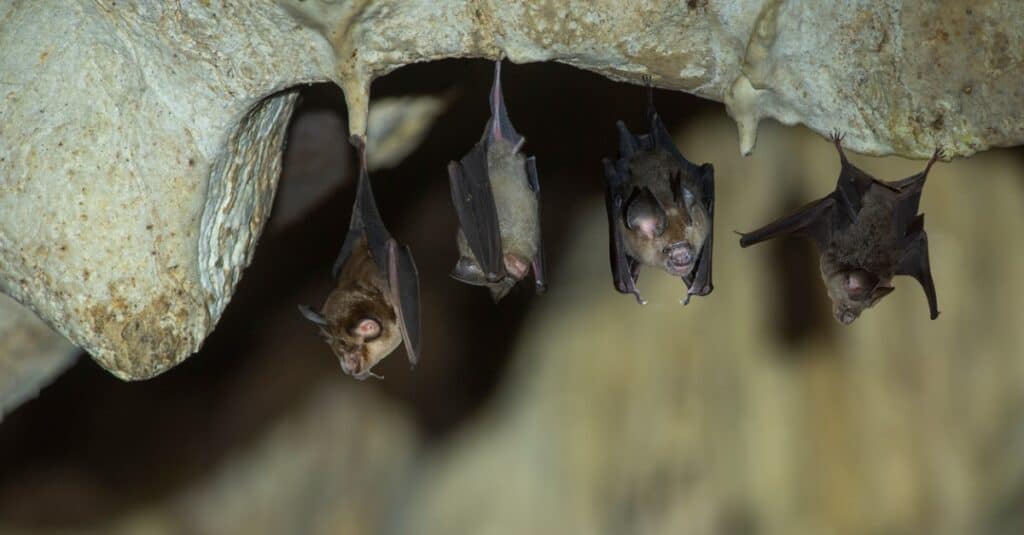South Dakota has rolling hills and grasslands with the Missouri river running through it and Badlands National Park. You will also find the infamous Mt. Rushmore and Crazy Horse monuments. The western border of the state is the Black Hills National Forest as well as Wind Cave National Park. With grasslands, rivers, forests, and caves what kind of wildlife are present in South Dakota, and are any of the wild animals that you may encounter dangerous? Let’s find out about the most dangerous animals of South Dakota.
Coyotes Attacks: Is the official state animal of South Dakota dangerous?

As omnivores, coyotes use their teeth to eat other mammals and carrion meat
©Derek R. Audette/Shutterstock.com
The state animal of South Dakota is the coyote and they can be found throughout the state with larger populations along the Missouri River and in the Black Hills. Coyotes are smaller than wolves but larger than bobcats, and are typically the size of a medium dog, weighing 20-45lbs. They are highly adaptable animals with a varied diet which makes them a common animal in most states throughout the US. They sometimes form packs to hunt larger animals. Some are capable of bringing down a white-tail deer on their own. Coyotes that live near urban and suburban areas will venture into residential areas in search of food and can dig through garbage, snack on pet food and sometimes even attack small pets.
A story from November 2018 out of Sioux Falls, SD reported two separate attacks on dogs in the same weekend. Both dogs happened to be Morkies (mix of a Yorkshire terrier and Maltese) and unfortunately, the first dog didn’t make it. The second one was rescued by its owner. Authorities reminded people to keep an eye on pets and not leave out pet food or garbage. They described a technique called “hazing” in which you yell, wave your arms and make loud noises in an effort to scare the coyote away. This can deter them from becoming comfortable around humans. While coyotes can be dangerous to small pets, attacks on humans are very rare.
Are free-roaming bison in South Dakota dangerous?

Bison can be dangerous to humans, but attacks are rare. Keeping 100 yards from these large animals is the safest thing to do.
©Grey Mountain Photo/Shutterstock.com
In the Badlands National Park there are approximately 1,200 bison that roam throughout the park. According to the National Park Foundation, it is estimated that in the 1500s there were around 30 million bison (that’s right, 30 million!) that roamed the Great Plains area. By the late 1,800s, there were only around 1,000 left. Conservation efforts have revived the bison population in many states, but continued efforts are in place to maintain and grow the bison populations. At the Badlands National Park 50 bison were brought to the park in the 1960’s and another 20 were added in the 1980’s. It is encouraging to see how well they have repopulated that area. Bison are larger than you may think, weighing around 2,000 lbs. They can be 4-5 feet tall at the shoulder. In fact, bison are the largest mammal in North America, larger than moose and bears.
What makes them dangerous, besides their size, is their sharp horns and their ability to become aggressive quite abruptly. They can turn on a dime and charge, reaching speeds of 30 mph. If they are butting heads with another bison that is one thing but ramming their head into a human can cause serious injuries and in some cases death. In August of 2021 a woman that got too close to a herd of bison, including a mother and her calf, was attacked by one of the bison. It suddenly charged her and caught its horn on her pants dragging her around and eventually stomping off. A group of motorcyclists videotaped the incident and immediately went to her aid. She was flown to the hospital and reportedly suffered non-life threatening injuries. Park authorities remind people to keep your distance from these and all wild animals, maintaining a distance of 100 yards to avoid more unfortunate incidents such as this.
Are there Black Bears in the Black Hills?

Black Bears are not the most dangerous animal in South Dakota because there are no black bears in South Dakota.
©BGSmith/Shutterstock.com
Large populations of Black bears also used to roam the Great Plains area, but again after overhunting and habitat loss their numbers dwindled. After years of conservation efforts there are now healthy populations in the bordering states of Minnesota, Wyoming, and Montana. There are no breeding populations in South Dakota. An occasional bear has been sighted passing through the Black Hills. One was caught on a security camera at the Mystic Hills Hideaway south of Lead and Deadwood, SD. Despite the potential danger of bears there are few bear-human incidents that result in injury or death.
Yellowstone Park, which has a large population of grizzly bears and also a population of black bears, reports that since 1979 there have only been 44 bear attacks in the park. They continued, “the chances of being injured by a grizzly bear are approximately 1 in 2.7 million visits”. The park reminds people to keep their distance (at least 100 yards) from bears. Also, be prepared if you are hiking or camping in bear country. Never feed the bears and keep all food secured. If you do come across a bear they will typically leave you alone. If confronted have bear spray readily available, not stashed in the bottom of your backpack, have it ready!
What dangerous animals can be found at Wind Cave National Park and in your backyard?

Bats can be dangerous because they can carry diseases like rabies. Fatalities from rabies is low in the US with only an average of 1-3 per year. Wind Cave National Park in South Dakota has 9 different species of bats.
©iStock.com/BirdHunter591
There are 9 different species of bats that live in Wind Cave National Park. They hibernate in the caves to make it through the chilly South Dakota winters. Bats can live in a variety of habitats and can even live in your backyard. While bats have a bad reputation, with some people fearing a blood-sucking attach like a vampire, bats rarely bite humans. If you get bitten by a bat it is extremely important you seek immediate medical attention because bats can carry rabies. The CDC says that people should get “post-exposure prophylaxis (PEP), which combines rabies vaccine and rabies immune globulin to prevent infection after exposure to the virus.” The availability of this and the increase in pet vaccinations has drastically reduced the number of fatalities due to rabies. Although bats are the number one animal responsible for rabies-caused deaths, there is still only an average of 1-3 fatalities a year in the US.
One of the issues with bats is that they can spread disease between each other and in 2015 a project was started at Wind Cave National Park to study the transmission of White-nose syndrome (WNS), which is resulting in a high number of bat deaths. WNS is a disease that is caused by an invasive fungus, it attaches to the bats wings while they are hibernating and can cause dehydration and death. Education programs were implemented to teach people not to spread the fungus by not wearing any clothing or footwear that had been worn in other caves. While this is a deadly disease for bats, according to the US Department of the Interior, there have not been any human illnesses related to WNS. So while bats may seem dangerous, they are not the most dangerous animal in South Dakota.
A List of Dangerous Animals in South Dakota
In addition to all the animals listed above South Dakota also has a venomous snake species, the prairie rattlesnake. In 2018 a man passed away near Spearfish after being bitten by a prairie rattlesnake. He was in tall grass looking for his golf ball. The man was 70 years old and its believe cardiac arrhythmia was the primary cause of his passing. There are about 7,000 venomous snake bites on across the United States each year, but only an average of 5 are fatal.
Overall, the most deadly animal in South Dakota may simply be deer. In 2020 there were 4,847 crashes involving animals in the state. Between 2010 and 2019 there were almost 2,000 deaths across the U.S. from collisions involving animals.
Summary of the Most Dangerous (Deadliest!) Animals in South Dakota
| Rank | Animal | Reason |
|---|---|---|
| 1 | Coyotes | Mostly for domesticated pets and livestock |
| 2 | Bison | Due to size |
| 3 | Black bears | No breeding pairs, but pass through |
| 4 | Praire Rattlesnake | Venomous snake |
| 5 | Bats | Carry rabies |
| 6 | Mosquitos | Carries disease |
| 7 | Ticks | Carries disease |
| 8 | Deer | Vehicle accidents |
| 9 | Mountain Lions | Breeding population in eastern South Dakota |
| 10 | Bobcats | Dangerous to pets |
The photo featured at the top of this post is © Debbie Steinhausser/Shutterstock.com
Thank you for reading! Have some feedback for us? Contact the AZ Animals editorial team.






